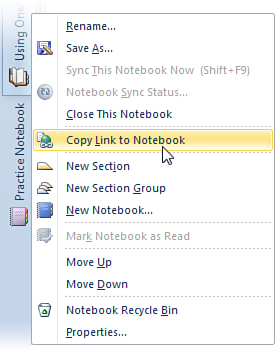Creating a Link to a Specific Notebook
To create a link in your current notebook that will open another notebook you have open, follow these steps:
1. | On
the navigation bar near the left side of the OneNote program window,
right-click the icon of the notebook that the link should open when it
is clicked.
|
2. | On the shortcut menu that appears, click Copy Link to Notebook (see Figure 3).

|
3. | Go
to the notes page in the notebook where you want the link to appear,
click to activate the cursor, and then press Ctrl+V to paste the link. |
When pasting links to notebooks, OneNote
automatically copies the notebook’s name into the link text so you
don’t have to type it again. It also formats the link in blue,
underlined text to indicate that it is clickable.
|
After the link has been pasted, clicking it will
immediately open the notebook it points to. To return to the previous
notebook, click the Back button on the Quick Access Toolbar near the
upper-right corner of the OneNote program window.
|
If the notebook you want to link to isn’t shown on
the navigation bar, click the File tab, click Open, and then either
click the notebook from the Recently Closed Notebooks list or click the
Open Notebook button.
Creating Wiki-Style Links to Other Locations in Your Notebook
If you’re familiar with wiki editing and it’s
something you plan to do with OneNote, you’ll be happy to learn that
OneNote supports the bracket syntax that lets you create navigational
links to your pages, sections, and notebooks without using the
interface.
To create a link to an existing place in your notebook, do the following:
1. | In your notes, where you want the link to appear, type [[ (two left brackets) to begin the link.
|
2. | Immediately
following the opening brackets, type the name of the page, section, or
notebook that you want to link to. This text must exactly match the
name of your link target.
|
3. | To end the link, type ]]
(two right brackets). As soon as you type the last bracket, the text
will change to a blue, underlined, clickable link that will point to
the page, section, or notebook name that you specified.
|
It’s important to note that, while wiki link names
can have spaces between words, there should be no space immediately
following the opening pair of brackets and preceding the closing pair
of brackets.
If the name of your link target exists, the link
that will point to it will appear underlined with a solid line, just
like a normal link. If you type the title of a page or the name of a
section or notebook that doesn’t exist, OneNote creates a new, blank
page with the name you typed for the link and places this page in the
current section of the notebook that you’re presently working in. Blank
pages that are created and linked to in this way are formatted with a
blue, broken underline (see Figure 4) to signal that, while the target page has been created, you’ll need to add content to this page at some point in the future.

|
If OneNote creates a new, blank page as the target
of a wiki link and you then delete this page, the link to that page
remains. If you click the link in your notes, OneNote opens the deleted
page in the notebook’s Recycle Bin, from which you can move it back
into your notebook. The opportunity to restore pages in this way
expires after 60 days from the day the page was originally deleted.
|
If you have both a section and a page in your
notebook that have the same name, automatic wiki links will favor the
page first. If you want to create a navigational link to both the page
and the section that share the same name, you can use the wiki link
syntax to create the link to the page and then use the manual link
creation for the section by right-clicking the section tab, clicking
Copy Link to Section, and then pasting that link into your notes at the
location you want it to appear. Similarly, because pages are given
preference, you cannot create a new section by typing a new name as a
wiki link, as this will create a new page. To create a new section that
you can then link to, right-click any existing section tab at the
location the new section should appear, and then click New Section on
the shortcut menu.
As is the case with manually created navigational
links, wiki links that you create from typed text are automatically
maintained even if you move pages and sections around in your notebook
after the links have been created. Similarly, your navigational links
won’t break if you change the names of the pages, sections, or
notebooks to which they point. OneNote automatically updates and
maintains them as needed.
If, for some reason, you prefer to create
navigational links by selecting their destination from a list, you can
use the quick filing menu to create a link. To do this, click in the
line of text where you want to create your link and then press Ctrl+K
to display the Link dialog box. In the lower half of the dialog box,
navigate to and then select the destination of the link. When you click
OK, OneNote inserts a formatted link to the page, section, or notebook
that you selected.
Now that you know how to organize information in
your notebooks by adding optional navigation, it’s time to learn how
you can move things around when needed.